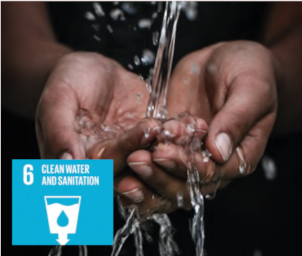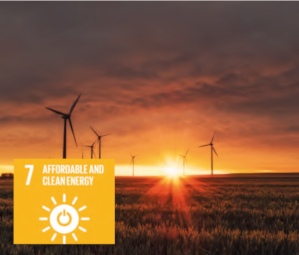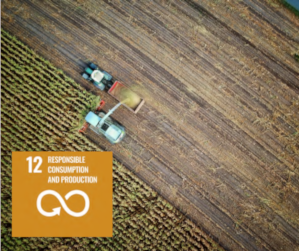UN Sustainable Development Goals
This page linking the UN Sustainability Goals to HSP was created in July 2024 by Amanda Svenstrup Poulsen as part of her Masters degree at Copenhagen Business School.
We are grateful to Amanda for producing such an excellent document.
SDG 3: GOOD HEALTH AND WELL-BEING
SDG 6: CLEAN WATER AND SANITATION
SDG 7: AFFORDABLE AND GREEN ENERGY
SDG 9: INDUSTRY, INNOVATION AND INFRASTRUCTURE
SDG 12: RESPONSIBLE CONSUMPTION AND PRODUCTION
SDG 13: CLIMATE ACTION
SDG 14: LIFE BELOW WATER
SDG 15: LIFE ON LAND
SDG 3: GOOD HEALTH AND WELL-BEING
 SDG 3 is about ensuring healthy lives and promoting well-being for all ages. Sustainable practices promote the development of safer and more effective pharmaceuticals, reduce exposure to hazardous substances, and improve environmental health, thereby contributing to better health outcomes.
SDG 3 is about ensuring healthy lives and promoting well-being for all ages. Sustainable practices promote the development of safer and more effective pharmaceuticals, reduce exposure to hazardous substances, and improve environmental health, thereby contributing to better health outcomes.
Using HSP to design pharmaceuticals and personal care products can reduce harmful side effects and eliminate environmental pollutants. This promotes better health outcomes and reduces medical costs. Here are examples of how HSP have been utilized by companies to support good health and well-being:
- DNA: HSP has been used to understand the solubility of DNA in solvents. This has helped to improve cancer analysis.
- Mechanism for DNA Chemotherapy Drugs: HSP has demonstrated the mechanism of action of chemotherapy drugs showing that they interact optimally with DNA.
- Skin Absorption (Drug Delivery): HSP has assisted in formulating topical drugs that are better absorbed through the skin, improving therapeutic outcomes.
- Fragrances and Aroma Chemicals: HSP has ensured the safe formulation of fragrances, reducing potential allergens and harmful chemicals.
- Foodstuffs: HSP has assisted in enhancing the stability and safety of food additives and packaging, ensuring consumer safety.
- Formulated Products: HSP has aided in the creation of safer consumer products, from cosmetics to household cleaners, by ensuring they are less toxic and environmentally friendly.
- Eye Irritation: HSP has been used to predict and mitigate the potential for eye irritation in various products, improving consumer safety.
- Packaging for Drug Compositions: HSP has been used to ensure that packaging materials are suitable for the drug compositions they contain, preserving drug efficacy and safety.
- Cholesterol, Blood Serum, Fat: HSP for such materials can lead to innovate solutions to many problems.
SDG 6: CLEAN WATER AND SANITATION
 SDG 6 is about ensuring availability and management of water and sanitation for all. Sustainability is crucial for developing technologies and practices that ensure the availability and continued management of water and sanitation for all. This includes water purification, wastewater treatment, and the reduction of water pollution through non-toxic and biodegradable chemicals.
SDG 6 is about ensuring availability and management of water and sanitation for all. Sustainability is crucial for developing technologies and practices that ensure the availability and continued management of water and sanitation for all. This includes water purification, wastewater treatment, and the reduction of water pollution through non-toxic and biodegradable chemicals.
Innovative use of HSP can help design water treatment, products, processes and filtration materials, ensuring clean and safe water. Here are examples of how HSP have been utilized to support clean water and sanitation:
- Filtration Membranes: HSP can guide the selection and design of membrane materials that effectively filter contaminants from water, improving the efficiency of water purification processes.
- Permeability of Plastic Pipes: By understanding the solubility parameters, companies can develop plastic pipes with optimal barrier properties, ensuring that harmful chemicals do not leach into the water supply.
- Chemical Resistance: HSP can be used to design materials that resist chemical degradation, ensuring the longevity and reliability of water treatment systems and infrastructure.
SDG 7: AFFORDABLE AND GREEN ENERGY
 SDG 7 is about ensuring access to affordable, reliable, sustainable and modern energy for all. Sustainability requires the development of renewable energy technologies, such as wind turbines, biofuels, solar cells, and energy storage solutions.
SDG 7 is about ensuring access to affordable, reliable, sustainable and modern energy for all. Sustainability requires the development of renewable energy technologies, such as wind turbines, biofuels, solar cells, and energy storage solutions.
HSP are most helpful in developing processes and materials for renewable energy technologies, such as more efficient battery electrolytes and materials for solar cells. Here are examples of how HSP have been utilized by companies to support affordable and clean energy:
- Atmospheric Pollutants: The HSP for atmospheric pollutants are known. This could provide clues for their improved capture.
- Lithium Batteries: HSP can help in selecting and optimizing electrolytes and other materials that enhance battery performance, lifespan, and safety.
- Solar Cells: HSP assist in the design of materials that improve the efficiency and durability of solar cells. These more effective solar panels contribute to increased adoption of solar energy.
SDG 9: INDUSTRY, INNOVATION AND INFRASTRUCTURE
 SDG 9 is about building resilient infrastructure, promoting inclusive and sustainable industrialization, and fostering innovation. The need for sustainability drives innovation in industrial processes and infrastructure, making them more efficient and less polluting. This includes the development of green manufacturing processes and substitution to more sustainable materials.
SDG 9 is about building resilient infrastructure, promoting inclusive and sustainable industrialization, and fostering innovation. The need for sustainability drives innovation in industrial processes and infrastructure, making them more efficient and less polluting. This includes the development of green manufacturing processes and substitution to more sustainable materials.
HSP have led to the development of many innovative and sustainable patentable industrial processes. They aid in creating products with improved performance and lower environmental impact. Here are examples of how HSP have been utilized by companies to support industry, innovation, and infrastructure:
- Polymers: HSP are used to optimize polymer formulations, leading to materials that are stronger, more durable, and environmentally friendly.
- Solvents: HSP help in selecting and developing greener solvents that are effective yet less harmful to the environment, reducing industrial pollution.
- Pigments: By using HSP, companies can develop pigments with improved dispersibility and stability, resulting in better product performance and reduced environmental impact.
- Nanoparticles/Carbon Nanotubes/C60: HSP assist in the design and dispersion of nanoparticles, including carbon nanotubes and fullerenes (C60), enhancing their integration into industrial applications like electronics and materials science.
- Selection of Chemical Protective Gloves: HSP are used to select materials for chemical protective gloves, ensuring they provide effective protection against hazardous substances.
- White UV Coatings without White Pigments: HSP help in formulating UV coatings that achieve desired properties without the need for traditional white pigments, leading to more sustainable products.
- Ceramics (HSP for Powder/Anchor/Binder): In ceramic production, HSP guide the selection of powders, anchors, and binders, resulting in stronger and more durable ceramic materials.
- Optimized Asphalt Compositions: HSP are used to optimize the composition of asphalt, improving its durability and performance while reducing its environmental footprint.
- Conductive Inks: HSP aid in the development of conductive inks, which are essential for printed electronics and other advanced manufacturing applications.
- Explosives: The HSP for explosives has enabled improved safety and reduced environmental risk.
- Three-Dimensional Printing: HSP guide the selection of materials for 3D printing, ensuring better performance and sustainability of the printed products.
SDG 12: RESPONSIBLE CONSUMPTION AND PRODUCTION
 SDG 12 is about ensuring sustainable consumption and production patterns. This SDG focuses on sustainable management and efficient use of natural resources, minimizing waste, and encouraging recycling.
SDG 12 is about ensuring sustainable consumption and production patterns. This SDG focuses on sustainable management and efficient use of natural resources, minimizing waste, and encouraging recycling.
HSP enable the formulation of sustainable products and processes that reduce waste, enhance recycling, and minimize the use of hazardous substances. This promotes more responsible consumption and production patterns. Improved working environments may also be possible. Here are examples of how HSP have been utilized by companies to support responsible consumption and production:
- HSP as an Analytical Tool: HSP provide a scientific basis for analyzing and predicting the behavior of materials, leading to more efficient and sustainable formulations.
- Ionic Liquids: HSP can guide the development and use of ionic liquids, which are environmentally friendly solvents with low volatility and high thermal stability, reducing environmental impact.
- Supercritical Carbon Dioxide: HSP are used to optimize processes involving supercritical carbon dioxide, a green solvent that reduces the need for hazardous chemicals in various applications, including extraction and cleaning.
- Subcritical Fluid Extraction (Food): HSP assist in designing subcritical fluid extraction processes which are used in the food industry to obtain high-quality extracts without harmful solvents.
- Cosmetics: HSP help formulate safer and more effective cosmetic products by selecting ingredients that are less harmful to the environment and human health.
- Vapor-Liquid Equilibrium: HSP can be applied to vapor-liqiud equilibrium processes.
- Mixed, Safer Solvents: HSP enable the formulation of solvent mixtures that are less hazardous, replacing more harmful solvents and reducing occupational and environmental risks.
- Bio-Based Solvent Certification: Obtaining certification (EU) for bio-based solvents requires their HSP to show how they may be used.
- Creating Gels (Optics, Cosmetics): HSP guide the creation of gels used in optics and cosmetics, ensuring they are effective while being safe and sustainable.
- Innovative Process for Contact Lenses: HSP have been used to develop innovative processes for manufacturing contact lenses, improving their quality and sustainability.
- Ink-Jet Inks: HSP help formulate ink-jet inks that perform well and support sustainable printing practices.
SDG 13: CLIMATE ACTION
 SDG 13 is about taking urgent action to combat climate change and its impacts. Sustainability contributes to climate action by developing processes and products that reduce greenhouse gas emissions. Innovative products in sustainable chemistry are essential for mitigating climate change impacts.
SDG 13 is about taking urgent action to combat climate change and its impacts. Sustainability contributes to climate action by developing processes and products that reduce greenhouse gas emissions. Innovative products in sustainable chemistry are essential for mitigating climate change impacts.
HSP have been used for years to develop low-VOC (volatile organic compounds) products. New thinking can provide clues as to how to develop or improve products. Here are examples of how HSP have been utilized by companies to support climate action and combat climate change and its impact:
- Flexographic Inks with Zero Release to the Atmosphere: HSP guide the formulation of flexographic inks that do not release volatile organic compounds into the atmosphere, significantly reducing air pollution and greenhouse gas emissions.
- Organic Photovoltaic (OPV) Solar Cells: HSP assist in developing materials for OPV solar cells, which are a sustainable energy source.
- Bio-Polymers: HSP are used to optimize the use of bio-polymers. These are derived from renewable sources and have a lower environmental impact compared to conventional plastics. These bio-polymers help reduce dependency on fossil fuels and decrease greenhouse gas emissions.
- Recycling Plastics (including Fiber): HSP are applied to improve the recycling processes of plastics, including fibers. By understanding the solubility parameters, companies can more effectively separate and recycle different types of plastics, reducing waste and promoting a circular economy.
- Products with Lower VOC Content: HSP help in formulating products with lower VOC content, which are less harmful to the environment and human health. These products contribute to reducing air pollution and greenhouse gas emissions, aligning with climate action goals.
- Poly Lactic Acid (PLA): HSP facilitated the development of products based on PLA (see PLA), a biodegradable polymer made from renewable resources. PLA can reduce plastic waste, supporting climate action efforts. However, PLA does not really have a major positive effect based on a Life Cycle Analysis.
SDG 14: LIFE BELOW WATER
 SDG 14 is about conserving and sustainably using the oceans, seas and marine resources for sustainable development. Protecting marine environments from chemical pollution is a significant aspect of sustainability. This includes reducing harmful chemical discharges, developing biodegradable materials, and ensuring safe wastewater treatment.
SDG 14 is about conserving and sustainably using the oceans, seas and marine resources for sustainable development. Protecting marine environments from chemical pollution is a significant aspect of sustainability. This includes reducing harmful chemical discharges, developing biodegradable materials, and ensuring safe wastewater treatment.
HSP help in designing biodegradable and less toxic products, reducing the impact of pollutants on marine ecosystems. This is crucial for the possible development of new and innovative solutions to help reduce the impact of microplast and break harmful cycles such as PCB. Here are examples of how HSP have been utilized by companies to support life below water:
- Eliminate Hazardous Chemicals: HSP guide the formulation of products that avoid the use of hazardous chemicals. By selecting safer alternatives, companies can reduce the risk of these chemicals entering marine environments.
- Can the Culprit be Caught?: HSP can help identify and eliminate the sources of marine pollutants. By understanding the solubility properties of various chemicals, it is possible to design materials and processes that prevent these pollutants from entering the oceans, thereby protecting marine ecosystems.
- Microplastics and Plastics in General: HSP can be used to develop biodegradable polymers that break down more easily in marine environments, reducing the accumulation of microplastics. This helps in mitigating the long-term impact of plastic pollution on marine life.
- There Are Challenges to Be Met: Despite the advancements, challenges remain in completely eliminating pollutants from marine environments. HSP provide a scientific basis for addressing these challenges by enabling the development of materials and processes that are less harmful to aquatic ecosystems.
SDG 15: LIFE ON LAND
 SDG 15 is about protecting, restoring and promoting use of terrestrial ecosystems. This includes sustainably managing forests, combatting desertification, and halting and reversing land degradation, and halting biodiversity loss. Sustainable practices help protect terrestrial ecosystems by substitution or reducing the use of hazardous chemicals in agriculture and industry, by promoting sustainable land management practices, and by supporting biodiversity.
SDG 15 is about protecting, restoring and promoting use of terrestrial ecosystems. This includes sustainably managing forests, combatting desertification, and halting and reversing land degradation, and halting biodiversity loss. Sustainable practices help protect terrestrial ecosystems by substitution or reducing the use of hazardous chemicals in agriculture and industry, by promoting sustainable land management practices, and by supporting biodiversity.
HSP can contribute to the development of more acceptable pesticides and other products that minimize soil and water contamination, thus preserving terrestrial ecosystems and promoting biodiversity. Here are examples of how HSP have been utilized by companies to support life on land:
- General: The use of HSP in various industries helps create products that are less harmful to the environment. For example, biodegradable solvents and safer chemical alternatives developed using HSP can reduce the ecological footprint on land-based ecosystems.
- Can the Culprit Be Caught or Substituted Away?: HSP assist in identifying and replacing harmful chemicals with safer alternatives. By understanding the solubility properties of various substances, companies can design products that are less likely to contaminate soil, air, and water, thus protecting terrestrial ecosystems.
- Second-Order Issues (Plastic, Grain, etc.): HSP can be used to develop biodegradable plastics and more sustainable agricultural practices. This helps in reducing the long-term impact of plastic waste and chemical runoffs on terrestrial ecosystems, thereby supporting soil health and biodiversity.